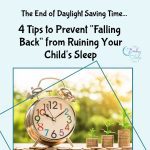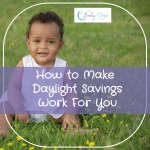Now that we’ve entered the month of March, we have something besides ice and snow to occupy our attention. The beginning of Daylight Saving Time. And if you have a baby or toddler at home, one thing is certain. You’ll want to make a plan, so that “springing forward” doesn’t result in too much sleep-and-feeding-schedule craziness.
And we’re here to help you make your plan! Today, we’ll explore 3 options for dealing with the upcoming time change. We’ll also review a short list of general tips for making DST easier for everyone.
3 Scheduling Options To Make “Springing Forward” Easier
What can you do to prevent springing forward for Daylight Saving Time from wreaking havoc on your baby or toddler’s schedule? Let’s take a look at your options:
- Don’t do anything. This is the best option for parents whose babies or toddlers are currently waking too early. If that’s the case, then simply “go with the flow” of the time change. Do that, and the baby who was waking at 5 a.m. will now wake closer to 6. The toddler who was rising at 6 a.m. probably won’t wake until 7. Early rising problem solved! Meals, nap times, and bedtime will also (probably) adjust themselves accordingly.
Of course, this isn’t always an option. If your baby or toddler already has a late bedtime, then it might not be feasible to have bedtime happen a whole hour later. Or perhaps you need your child out of bed and ready to go at a certain time each morning. If that’s the case, then letting her sleep in for an extra hour won’t be possible.
This option also won’t work for parents who happen to like their baby or toddler’s current schedule, thank you very much, and don’t want to change it.
This brings us to option 2…
- Stick to your child’s normal schedule. You’re not actually doing any schedule shifting here. You’re simply observing your baby or toddler’s “old” times for meals, naps, and bedtime. So, for example, if your baby was consistently waking at 7 a.m. before the time change, then wake her at 7 a.m. after the time change (even though 7 a.m. was 6 a.m. just a few days ago.)
Similarly, if your toddler was going to bed at 8 p.m. before the time change, then put him to bed at 8 after the time change (even though 8 p.m. was 7 p.m. just a few days ago.) Do the same for naps and meals.
Make sense? This is definitely more of a schedule-oriented method than a child-oriented method, and you may find that it doesn’t work out perfectly at first. Your baby may not sleep at all when her bedtime rolls around since her internal clock is telling her that it’s too soon for bed. Or your toddler may be sleepy in the morning, even though you’re waking him at his normal wake-up time because his internal clock is telling him it’s too early to wake up. Same with naps and meals.
However, after a few days (or maybe a week), your baby or toddler will probably adjust. And if you really, really want (or need) to preserve your current schedule, then this is the option you’ll probably want to try first.
- Split the difference. This is a nice, middle-of-the-road option for parents who can’t let DST shift their schedule by a whole hour but who also know that sticking to the old schedule won’t work well for their situation.
With this option, you shift the schedule by 30 minutes. So, the example scenarios would look like this: if your baby was waking at 7 a.m. before the time change, then wake her at 7:30 after the time change. If your toddler was going to bed at 8 p.m. before the time change, then put him to bed at 8:30 after the time change. Adjust naps and meals by 30 minutes, too.
You can stick with this schedule long-term, if it works for you. But if you want to get back to your pre-DST schedule, you can do that, too. Simply go with the “split the difference” routine for a few days/weeks. Then, shift everything back to its original time. So, in the above scenarios, your baby’s wake time would return to 7 a.m. (as opposed to 7:30 a.m.), and your toddler’s bedtime would go back to 8 p.m. (as opposed to 8:30 p.m.)
This is a nice way to ease your baby or toddler into the time change. It keeps the “post-DST” schedule pretty consistent with the current schedule, but it also accounts for your baby’s or toddler’s internal clock.
Tips to Remember When Planning for Daylight Saving Time
Regardless of which option you end up choosing, be sure to keep these tips in mind as you create your DST plan:
- Our internal clocks are powerful things. Some babies’ and toddlers’ internal clocks will be so strong, they’ll defy your carefully-planned schedule. Try as you might, you won’t be able to get your toddler into bed at 8 p.m. His internal clock will be too busy screaming, “But it’s only 7!” And really, our adult clocks behave the same way, don’t they? In my pre-kid days, I had to wake up for work at 5:30 each weekday morning. And on Saturdays, the one blessed day each week that I had a chance to sleep as late as I wanted, guess what time I usually woke up? Yep. 5:30 a.m.I repeat: your child’s internal clock is a powerful thing. So respect it as you create your post-DST schedule.
- Two things will drive your child’s schedule: sunlight and routine. Simply put, sunlight tells us it’s time to wake up (and stay awake). As we approach summer, and our days start to get longer, and our nights shorter, you may find that the extra sunlight is impacting bedtime (making it later) and wake-up time (making it earlier). If that becomes an issue, consider investing in some good room darkening shades. This’ll help keep your baby or toddler on track, sleep-wise.The daily routine will also help create and reinforce your child’s sleep schedule. As you’re working to adjust to DST, remember — now is the time to stick with your predictable, daily routines! Doing so will help your baby or toddler adjust to the time change faster.
- Most children will adjust quickly, but some will take longer. Most babies and toddlers will adjust to the time change in a week or so. For some though, it may be more like weeks, with an “s”! If that’s the case with your baby or toddler, don’t panic. Simply ride out this season and trust that as long as you stay consistent, things will work themselves out. Of course, if they don’t, you can always contact us for help! Click here to view our consultation packages.









